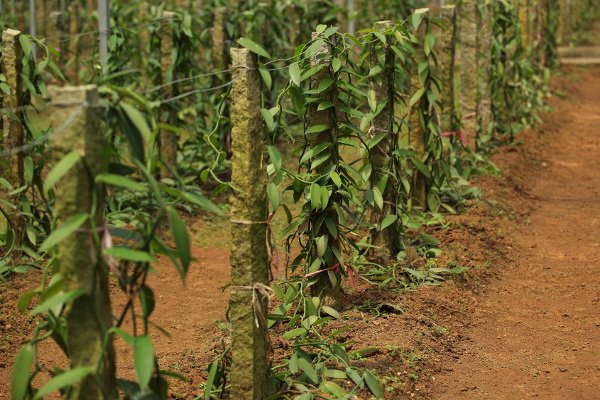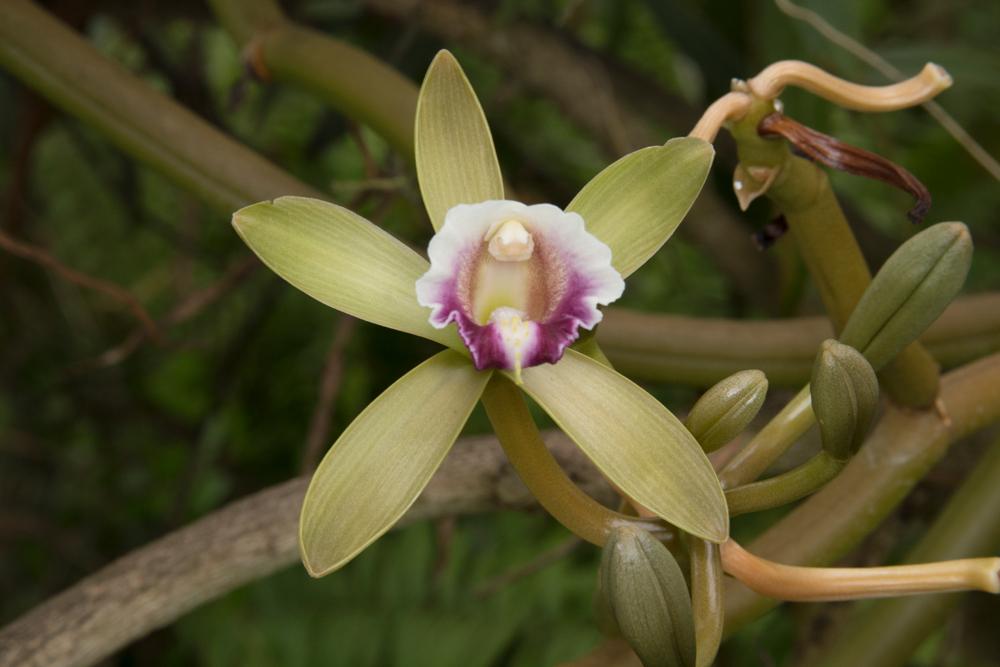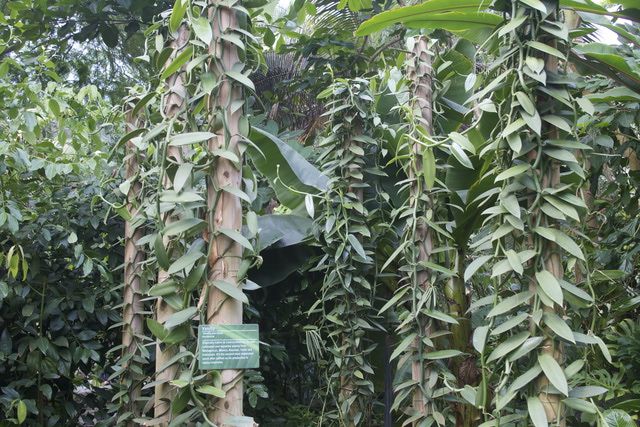Vanilla is a ubiquitous flavor. Almost everyone that you come across loves the taste and flavor of vanilla in some way or the other. From baking to daily cooking, the use of vanilla is quite profound. However, you need to realize that growing vanilla isn’t as easy as it sounds. There are quite a few important steps involved in the process.
If you have never seen a vanilla plant before, be assured that they are climbing creepers, so not just the growing parameters, you need to be mindful of the space that you provide the plant with. Since vanilla pods are generally grown in orchards for commercial use, it isn’t surprising that their growing parameters are quite stringent.

But, with the controlled environment and optimal knowledge, you shouldn’t have any issue growing your favorite flavor right in your home. Compared to the essence or extract that you get in the market, using a natural vanilla pod has its benefits. We will discuss everything about growing vanilla from scratch in this guide.
Vanilla Growing Care Guide – Overview
Before we delve into discussing more growing vanilla in a controlled environment, let us give you a quick rundown of the instructions. Here’s what you need to know:
| Growing needs | Description |
| Common name | Vanilla, vanilla orchid, west Indian vanilla |
| Scientific name | Vanilla planifolia or Vanilla tahitensis |
| Light | Indirect sunlight |
| Water | Light but consistent |
| Harvesting duration | 180-270 days |
| Soil | Well-draining, combo bark |
| Pests | Spider mites, mealybugs |
| Fertilizer | Nitrogen enriched full spectrum fertilizer |
| Diseases | Root rot |
Having a basic idea about the vanilla plant’s care guide will help you come back and refer to it when you are finally ready to grow your plant in the garden. Since it needs a very controlled environment for growing, it isn’t surprising that you need to be mindful of the process of growing the plant.
A little bit about Vanilla
When it comes to flavoring, vanilla is a staple for many individuals. It adds a subtle taste and flavoring to a baked good that’s not too overpowering but somehow blends in with anything that you are cooking.
The incidence of Vanilla stems from the North American region. It is also native to Guatemala, Belize, and Mexico. The growth of vanilla is generally profound in tropical countries since it needs a constant dry and sunny climate to grow without pests and diseases. However, you need to realize that vanilla grows as creeper vines.
Generally, the vines grow in a zig-zag manner and have elliptic leaves, which make them a worthy choice for you to look into. The unique thing about a vanilla plant is the process of pollination.

You have to wait for a few years for the plant to bear white-, greenish- or yellow-colored flowers, which grow for a day and need to be pollinated during that period. If no pollination occurs, the flowers eventually droop.
However, if the pollination is successful, the vanilla plant starts bearing the fruits. A first look at the fruit resembles that of a banana and it takes over 6 months more for the fruit to mature and be harvested after that.
The aged and matured vanilla pods are then harvested and cured for the final extraction and usage. Once the vanilla seeds are extracted, the rest of the pod is macerated and then distilled to extract alcohol.
What are the different types of Vanilla?
Unless you are a baking or vanilla connoisseur, chances are that you won’t know much about the different types of vanilla seeds that are available in the market. Typically, there are around five different types that have very distinguishable flavors once you try them all.
Here’s a breakdown of each:
- West Indian Vanilla

This type is one of the most popular and features large, glossy green leaves with long stems that grow up to 5 meters in length. They are typically found in Mexico and South Tropical America and are known for contributing to the majority of vanilla production. They produce larger pods as well.
- Flat-leaved vanilla

The Flat-leaved vanilla grows on one of the largest vanilla plants that you will come across. The cultivar grows up to 30 meters, which is quite promising. Unlike most of the other types of vanilla that grow in dried areas, this one needs tropical but swampy areas to grow in.
- Tahitian Vanilla

As the name suggests, the Tahitian Vanilla is native to Tahiti. They grow broader and more pods than the West Indian variant. Like West Indian, even this variety is quite common and contributes to most of the vanilla production across the world. The flowers in this plant are yellow, which is different than the rest.
- Leafless Vanilla

Sounds fascinating, doesn’t it? The leafless vanilla is grown exponentially in several Southeast Asian countries. Unlike other variants, this one features a cluster of flowers that grow on the same plant. Instead of having leaves around, the leafless vanilla directly grows from the nodes and hence the name.
- Mexican Vanilla

The last on the list is Mexican vanilla, which is commonly found in Mexico, Central Florida, and a few areas in central and South America. It is another one of the most common types of vanilla. Besides the strong flavor, what sets this apart from the rest is the small length. The plant grows up to 2 feet in length.
How do you Plant a Vanilla Plant?
Now that you have a clear idea about the different types of vanilla plants, the next factor that we need to look out for is the planting process. How does one plant it?
Should you get some seeds and throw them in the soil? Well, surprisingly the answer is no. That’s not how you should be planting the vanilla plants.

Instead, you first need to assess the environmental conditions. If the growing parameters aren’t right, you won’t see any results from the efforts that you are putting in.
Besides Florida, if you want to grow vanilla beans, you need to grow them in small pots filled with the orchid potting mix. This is highly mandatory. Also, since these are creepers, you need to provide a pole in the middle of the pot as a support so that the creepers can climb upwards.
Also, sanitize every cutting element that you use in growing the plants. This is mandatory and ensures that your bottom roots are removed strategically. Once done, you can then plant the rest of the plant to add to the stake and the pole.
How to Care for a Vanilla Plant?
Caring for a vanilla plant’s growth can be a little tricky. You need to be mindful of the growing environment and ensure that nothing goes out of bounds.
For your convenience, we have sorted out all the major factors worth considering:
- Sunlight and temperature parameters
Although you need a dry, tropical climate to grow your vanilla plant, it doesn’t need direct sunlight. Instead, you need to grow it somewhere with indirect sunlight exposure during the morning and evening time. During the afternoons, you have to look into the filtered shade.

The reason why vanilla plants don’t enjoy direct sunlight is due to their sensitivity. Excess sunlight runs the risk of burning the plant and the leaves, which is the absolute last thing you want. This is one of the reasons why expert growers prefer using a greenhouse for growing vanilla plants.
As for the temperature settings, vanilla plants need between 75-85 degrees Fahrenheit for them to grow. Anything more or below that will drastically impact the quality of the plant in the long run. If the temperature rises or falls too drastically, chances are that the same will damage the leaves and lead to yellowing and drooping.
- Water parameters
Although vanilla grows in tropical climates, it needs well-drained but moist soil to grow and thrive. This is mandatory and not a choice. So, if you find the soil going dry, replenish the same with 2-3 inches of water.
However, once the plant starts to bloom, you need to wait before you rewater them. Ideally, we’d recommend that you wait for the soil to completely dry out before you water them again.

Also, in terms of humidity requirements, vanilla plants need around 85% humidity in their surroundings. If you are growing the plant indoors or in the greenhouse, maintaining the humidity is easy with the grow tent controls.
If you have humidity trays available, you can include that as well. However, if you live in areas with very low humidity, the best way to control that is with a humidifier. It sorts out a lot of the complications. Despite the season and the temperature outside, the humidity is the one factor that you can’t forego with a vanilla plant.
Also, when watering your vanilla orchid plant, ensure that you use distilled water instead of the regular tap water. This might not seem like a lot but it makes a lot of difference in the growth of the plant in the long run.
- Soil parameters
Another factor that you need to look out for when growing a vanilla plant is the soil. Orchid potting mix is ideal in most cases but we’d recommend using a mix of orchid bark and the half sphagnum peat moss. If you aren’t the bigger fan of the moss, you can always switch it up with the bark composition entirely.
As for the soil’s pH, maintain it between 6.6 to 7.5. So, it should be slightly acidic or alkaline. If you can nail the soil and humidity settings, there shouldn’t be any complications arising in the process.
- Fertilizers
Do you need fertilizer for growing vanilla? The answer is yes, you do. However, not too much. Excess vanilla in the mix will do worse than good. So, you can start with a diluted version of the high nitrogen fertilizer for your soil and then watch the magic unfold.

Also, when you are adding fertilizer to the soil, we’d highly recommend that you opt for it when the soil is moist. This ensures that the fertilizer is readily absorbed into the soil. So, spray it with fertilizer in between the watering sessions for the best results.
- Pruning and training
Unlike most other plants, you don’t have to worry about pruning your vanilla plant much. The primary reason behind this is that it propagates on its own and that’s what most growers are looking for. However, you need to train the vine using a support pole.

What you can do is place the pole in the middle of the pot and then train it to propagate upwards. You can hang the vines in the surrounding areas with the help of nails, which adds to the benefits further.
- Propagation process
For propagating the vanilla plant, you will need cuttings. The oils that seep out of these cuts are quite strong, so always wear gloves when you are handling them. When cutting the stem for propagation, ensure that the stem is around 6-8 inches and has 2-3 nodes in them.
What are the pests and Diseases with Vanilla Plant Growth?
The vanilla plant is favorably resilient. However, you might have to look out for pests like spider mites and mealybugs. They infest the plant quite easily and can cause damage to the foliage and the blooms.
As for diseases, root rot is the most common issue that you need to look out for. Overwatering and lack of drainage are what lead to the risks of fungal root rots. So, ensure that you keep a check on how much moisture is there in the soil before you add more.
FAQs
1. How long does it take to grow vanilla beans?
If you are impatient about gardening, growing vanilla isn’t the best thing to grow since it takes more than 9 months for the plant to grow. Once the plants flower completely, they have to be hand-pollinated, which can be a little challenging. Following that, it takes the plant around 9 months to mature and make them ready to harvest.
2. How many vanilla beans can one plant produce?
A healthy and mature plant can produce up to 2 kg of green beans every year. But, after curing and complete drying, the beans fizzle down to around 0.3 and 0.4 kg of cured vanilla beans that you can grow without any hassle.
3. Is it profitable to grow vanilla?
If you are considering growing vanilla beans commercially, it is considered a very profitable business. Since they can be sold in different variants, including cured beans and dried pods sell for a very good price in the market.
4. Can vanilla be grown anywhere?
Growing vanilla isn’t easy to grow anywhere you want. It can be cultivated in a handful of regions and countries. Some of the most important spots include Mexico, Madagascar, Uganda, Indonesia, Tahiti, etc. In most cases, they grow well in tropical, sunny, and warmer weather conditions.
5. Does vanilla need full sun?
Vanilla requires bright and vivid sunlight but it doesn’t do well in the direct or hot climate in the area. So, if you are growing them, it is ideal that you grow them in partial shade and avoid direct sunlight.
6. Can vanilla be grown in the US?
Vanilla can be grown in the United States but in a few selected areas or states like Florida, Hawaii, Puerto Rico, etc. since the weather condition is optimal in those areas.
Conclusion
Growing a vanilla plant is an exciting and rewarding process. It is no doubt a tedious process but we can’t brush aside the fact that with the right parameters, you shouldn’t have any issue growing the plant. We hope that this article serves as a baseline for you to refer back to when it comes to growing this unique flavoring agent.

